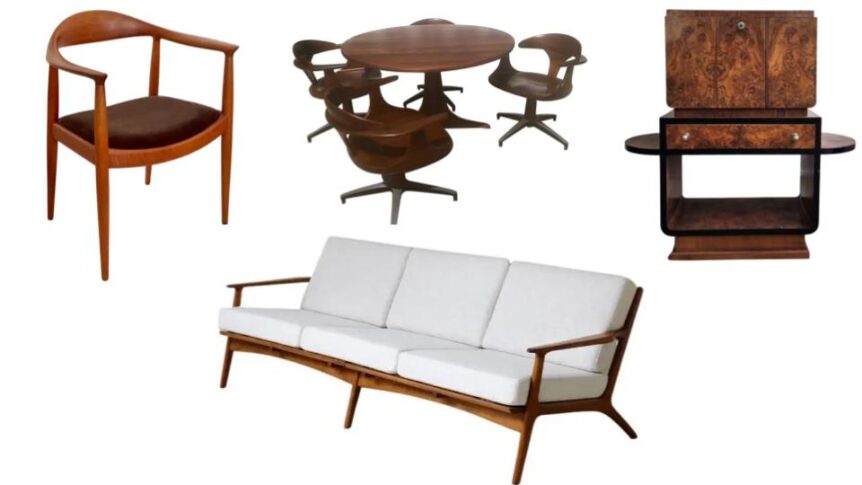Why Certain Vintage Furniture Styles and Brands Can Be Smart Long-Term Investments
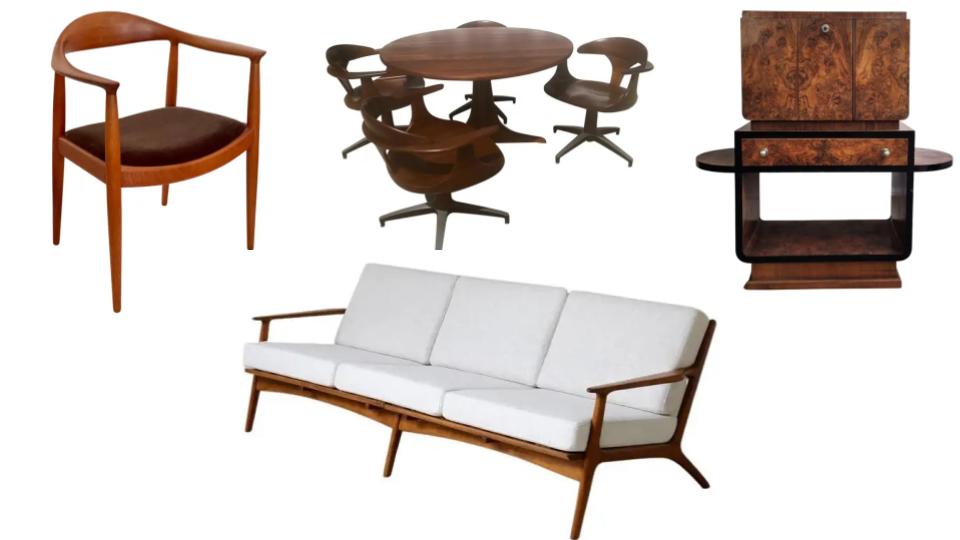
Vintage furniture has seen a major resurgence in popularity over the last decade. With its timeless designs and quality craftsmanship, it’s no wonder vintage pieces are sought after for adding character and charm to modern homes. In fact, It’s now so popular the online vintage retailer Charish predicts the market to reach $22B By 2027.
The appeal of vintage furniture has also caught the eye of investors and collectors looking to capitalize on rising prices. But does vintage furniture actually appreciate in value and make a good investment?
The short answer is yes, most vintage furniture does increase in monetary value over time. But there are several factors that determine whether a piece will appreciate or not, including the era it’s from, the brand, condition, provenance, and current trends that drive up demand.
In this article, we’ll look at what classifies furniture as vintage, break down the major design eras, analyze what influences the value, and provide tips for investing in vintage furniture.
Read on to learn why vintage furniture can be a smart investment when selected carefully.
What Makes Furniture “Vintage”
For furniture to be considered truly vintage, it generally needs to be at least 40-50 years old. Anything younger than that would be classified more as retro or antique-inspired. Here are some of the major design eras that produce vintage furniture:
Art Deco – 1920s/1930s
Art Deco originally grew out of the 1925 Paris Design Exhibition and reached its peak popularity in the late 1920s through the 1930s. It represented a reaction against the delicate curves of Art Nouveau and was considered very modern and forward-thinking at the time.
The aesthetic is defined by geometric repeating patterns, sleek lines, exotic materials like chrome and bakelite, and inlaid details and accents. Luxurious French brands like Ruhlmann and Sue et Mare pushed Art Deco furniture to new creative heights with custom-crafted cabinetry, chairs, tables, and more. Even mass-produced Art Deco pieces from the era display a level of quality craftsmanship hardly seen today.
Mid-Century Modern – 1940s-1960s
Emerging after World War II, Mid-Century Modern embraced mass production and new materials to create affordable, minimal, functional furniture for the American middle-class home. Pride in quality craftsmanship endured through Mid-Century, even as processes shifted from hand-built to machine-built.
Iconic designers like George Nelson, Charles and Ray Eames, Hans Wegner and others created timeless clean-lined, unfussy furniture that changed modern interior design. Danish influence drove the popular blonde wood trend. And developments in molded plastics and plywood enabled innovative new forms, like the Eames’ famous molded fiberglass and molded plywood chairs.
Retro/Kitsch – 1950s-1970s
As Mid-Century Modern gained widespread appeal in the 1950s and ‘60s, some began to view the sparse style as too sterile. This sparked a subsidiary Retro design movement that revived periods like Art Deco and Victorian with an exaggerated flair.
Distressed finishes, funky novelty hardware, bold wallpaper, and whimsical shapes characterized Retro furniture. Some dismissed it as kitsch or camp. But Retro made modernism more accessible and fun. Even major designers like Ettore Sottsass’ Memphis Group created quirky postmodern works. Affordable MCM brands like Lane and Broyhill introduced budget-friendly Retro-inspired lines.
Early American Colonial – 17th/18th century
Early American furniture refers to pieces hand-crafted from the colonial era into the late 1800s in simple utilitarian Country and Primitive styles. Rural joiners and carpenters built furniture locally from native woods like maple, oak, pine, and cherry.
Their techniques included mortise and tenon joinery with wooden pegs, and decorative flourishes like twig and splat turnings. Simple forms like trestle tables, four poster beds, blanket chests, and double chair settles typify Early American style. As fine examples from this period become increasingly rare, values have surged. Even crude country cupboards and gate-leg tables sell for thousands.
Victorian – 1837-1901
The Victorian era encompassed multiple furniture styles like French Rococo Revival, Renaissance Revival, and Gothic. But overall, Victorian pieces tend to display intricate carved details, exotic woods, embellishments, and lush upholstery.
Deeply tufted fainting couches, ornate cabinets, figural chairs and tables, and massive dining sets loaded with carvings typified Victorian flair. The emergence of mass production enabled more middle class homes to afford fashionable Victorian furniture. Hand-crafted custom pieces from respected companies like Kimbel and Cabus can still reach five to six figures today.
Related articles:
- 17 Best British Furniture Manufacturers From The 1950s, 60s & 70’s
- 20 Best Mid-Century Modern Furniture Brands
- How To Make a Modern House Look Vintage
Factors That Influence Value
Brand Name
Like with most collectibles, a respected brand or designer name can significantly boost value. Iconic examples include Herman Miller, Knoll, Hans Wegner, Charles & Ray Eames, Heywood Wakefield, Dunbar, and Drexel. These companies were known for excellent craftsmanship and for pushing furniture design forward in their eras. Their pieces were built to last through generations.
Lesser known brands can still appreciate over time, but likely won’t reach the stratospheric prices of the big names that collectors covet. Finding a forgotten gem at thrift-store prices from a lesser brand can represent a great deal. But when investing thousands on the secondary market, it pays to stick with established names that carry prestige.
Rarity
One-of-a-kind custom or limited production runs drive up value for their exclusivity. Pieces that were mass-produced typically don’t appreciate as much, unless they have a famous brand name attached. Limited edition iconic designs, like Eames lounge chairs, or custom Art Deco cabinets delivered for an elite client boost value tremendously.
Tracking down production numbers from the manufacturer can aid in determining rarity. Sometimes dealers advertise a piece as rare without evidence to back it up. Verifying actual scarcity ensures you don’t overpay for a supposedly rare piece that may have had widespread production.
Related articles:
- 17 Best British Furniture Manufacturers From The 1950s, 60s & 70’s
- 15 Best Mid-Century Sideboards (1960s-1970s)
Age
As mentioned previously, older vintage furniture tends to be worth more, but a high age alone doesn’t guarantee value. A poorly made 100-year old chair won’t be worth nearly as much as a mint condition 70-year-old Saarinen Tulip chair.
However, when comparing pieces of similar quality and condition, the older example usually commands a higher price. This premium for older age results from increased rarity as these pieces are more likely to have been lost, damaged, or destroyed over time.
Researching the production history helps date a piece. Some companies kept excellent records that make dating straightforward. Others may require expert assessment or appraisal to accurately determine age. An authenticated date of creation provides confidence in paying the value premium for greater age.
Condition
This is a big one. An immaculately kept vintage piece can be worth 10-20 times more than the same item in poor shape. Original finishes in good condition are ideal. Chips, cracks, threadbare upholstery, and amateur refinishing can significantly reduce resale value.
When evaluating condition, it helps to break it down into elements:
- Structural condition: Are all joinery and components intact without damage or repairs? Subtle nicks and dings are usually fine if structural integrity remains. But damage like broken legs or a warped tabletop can tank value.
- Finish: Is the original stain or paint finish still present without wear, fading, or flaws? A pristine finish boosts value exponentially, since refinishing almost always reduces worth for collectors.
- Upholstery/Textiles: This can be replaced without hurting value as long as the frames and base materials are unchanged. But patterned original upholstery on rare pieces does add value.
- Hardware: Having all the original pulls, handles, drawer glides, etc shows care was taken to preserve the piece intact over the years. Missing hardware detracts slightly from overall condition.
Inspecting through this lens provides a comprehensive view of condition to factor into valuation. The closer to original showroom state, the higher the market value in almost all cases.
Provenance
Being able to trace a piece’s origins and ownership history builds value through provenance. Vintage furniture that was custom made for celebrity clients or used in famous settings are especially sought after. For example, a chair or table custom built for Frank Sinatra’s lounge would carry a premium.
Providing concrete documentation proving provenance understandably boosts value significantly. At minimum, knowing some basic history on the previous owners helps. Though sometimes furniture originates from an intriguing historical setting despite a gap in its record. Even without ironclad documentation, a compelling likely origin story can still generate interest among collectors.
Restoration/Adaptation
Sympathetic restoration using era-appropriate materials can enhance value if done right. But amateur DIY repairs or overly invasive changes destroy integrity. Adaptive reuse into new forms, like a dresser converted to an entertainment unit, generally hurts value for purists.
Restoration should aim to bring a quality vintage piece back to original glory, without altering its fundamental form or design. This includes delicate repair of damaged areas, stripping previous bad repairs, and replacing worn upholstery with period-correct patterns and fabrics.
Well-executed restorations by respected experts do add to value. But extensive over-restoration creates a piece too pristine for some collectors, hurting market prospects. Finding the balance between gently restoring versus aggressively overhauling condition takes experience.
Trends
Vintage furniture prices ebb and flow with trends. Mid-century design surged in recent decades because of renewed interest. Conversely, Victorian and French styles have cooled a bit since their last heyday. Tracking current trends provides clues for which vintage pieces will likely appreciate most in the near term.
Regional tastes also produce variation in values. For example, Danish mid-century resonates more in Europe, while American kitsch and early colonial have stronger domestic appeal. Purchasing vintage styles popular in your area can be beneficial when reselling down the road.
Vintage trends often align with contemporary interior design movements. For example, industrial and minimalist spaces pair well with clean-lined Mid-Century Modern. While Early American Country complements the wildly popular modern farmhouse aesthetic.
When current fashion favors a vintage style, its market values usually climb accordingly. So pairing an understanding of interior decor trends with vintage furniture market analysis helps identify promising investment opportunities.
Related articles:
Case Studies: Brands and Styles that Have Appreciated
Here are some specific examples of vintage furniture brands and styles that have appreciated significantly over time:
Hans Wegner Chairs

Danish mid-century designer Hans Wegner created iconic chairs like the Wishbone Chair and Papa Bear Chair in the 1940s-1960s. At the time, they sold for around $100-200. Today, mint condition vintage Wishbones can fetch $2,000-$5,000 and Papa Bears even more.
Eames Molded Plastic Chairs

Husband and wife designers Charles and Ray Eames pioneered molded plastic chair technology in the 1940s-50s. Their fiberglass chairs were considered futuristic and sold for around $150 originally. These quintessential mid-century icons now sell for $2,000-$5,000 in excellent restored condition.
Heywood Wakefield Dining Sets
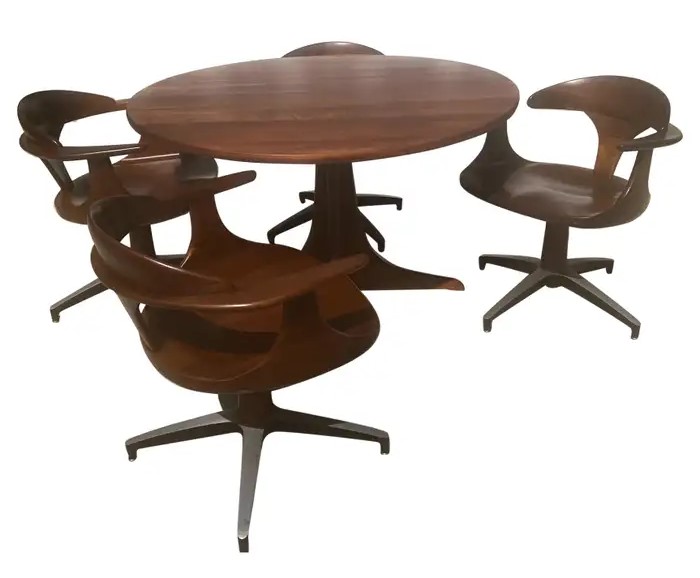
Mid-century American brand Heywood Wakefield gained fame for its blonde wood “Champagne” series in the 1950s-60s. A 6-8 seat dining set cost $1,000-1,500 at the time. Today, a full vintage Heywood Wakefield dining set can easily sell for $10,000-$15,000.
Early American Primitive Furniture
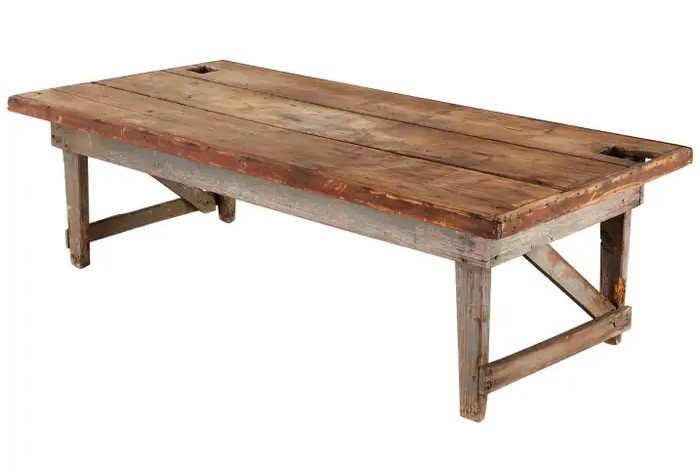
Rare surviving early American furniture hand-crafted from the 17th-18th centuries by anonymous rural craftsmen can realize tremendous value. For example, Sotheby’s has put a valuation of, an 18th-century New England Queen Anne dressing table of 5,000 – 8,000 USD.
Scandinavian Teak Furniture
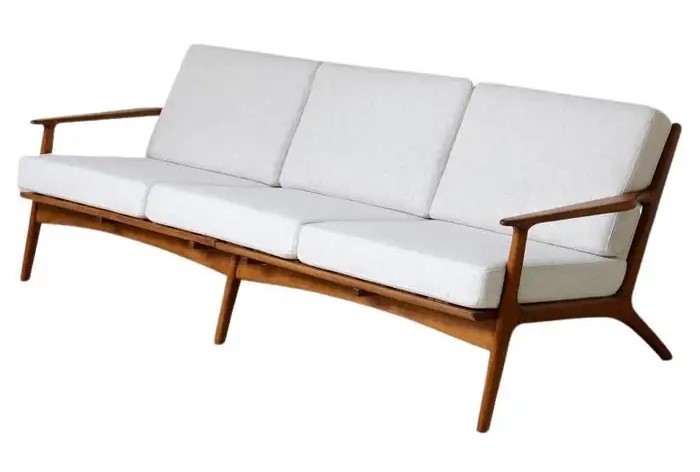
Danish and Scandinavian brands like Dansk, Dux, and Skovby built functional teak furnishings from the 1940s-1970s. Quality vintage Scandinavian sets are increasingly popular for their timeless styling. A vintage rosewood Danish sideboard and dining table could sell for $2,000-$5,000.
Art Deco Cabinets

Custom Art Deco cabinets from elite French designers like Ruhlmann, Majorelle, and Gray reach astounding prices at auction. For example, Sotheby’s has a 1930s lacquered cabinet by Ruhlmann with an estimated value of 80,000 – 120,000 USD. Even more affordable mass-produced Art Deco cabinets appreciate steadily, especially iconic brands like Kem Weber.
Current Trends Driving Demand
While vintage furniture prices fluctuate based on style trends, generally the most popular eras that attract high values today include:
Mid-Century Modern
This is arguably the hottest vintage style today. Mid-century’s clean lines and minimalist forms blend seamlessly into modern homes. Iconic designs by Charles & Ray Eames, Isamu Noguchi, George Nelson and other legends reach dizzying prices at auction. Even high quality mass-produced MCM brands like Knoll and Herman Miller carry premium values.
Art Deco
The ornate Art Deco aesthetic fits well with glamorous contemporary interiors. Quality original Art Deco furnishings from renowned designers like Emile-Jacques Ruhlmann can sell for six figures. More accessible mass-produced Art Deco pieces also appreciate steadily.
Early American
After a lull in recent decades, early American antiques from the 17th-19th centuries are regaining collectors’ interest. Updated finishes and adaptive reuse make primitive country furniture relevant in farmhouse-style interiors. Top-tier early American antiques sell for high five to six figures.
Hollywood Regency
Bold, dramatic, and glamorous – the Hollywood Regency style is having a comeback. This vintage aesthetic defined opulent 1950s-60s interiors with its exotic motifs, sparkling chandeliers, and elegant seating. Renewed popularity has increased values for original Tony Duquette and other prominent Regency furnishings.
Scandinavian Designs
Danish and Scandinavian vintage furniture is beloved for minimalist functionalism. Brands like Hans Wegner, Arne Jacobsen and Finn Juhl command premium auction values. Clean practical vintage pieces in teak and rosewood find eager buyers.
In summary, current interior design trends gravitate toward vintage styles with clean lines, minimalism, and natural materials – namely Mid-Century Modern and Scandinavian. While the opulent elegance of Art Deco and Hollywood Regency also resonates today.
Rustic primitive Early American enjoys renewed farmhouse appeal. These styles align with how people want to decorate their homes currently, fueling interest and value growth.
Tips for Investing in Vintage Furniture
If you’re interested in investing in vintage furniture, implementing a few best practices will provide the best chance of realizing appreciating values over time:
Focus on Top Tier Examples
The very best, high-quality examples of vintage furniture appreciate most reliably. Seek out pieces from top heritage brands known for fine materials and workmanship like Herman Miller, Hans Wegner, Dunbar, Heywood-Wakefield, Knoll, and other icons of the era. When possible, try to confirm the piece was made in the brand’s home country during their prime production period for potentially greater value.
Verify Provenance When Possible
Documenting the ownership history and origins of a vintage piece boosts provenance. Famous past owners or uses can significantly increase value. For example, a chair or table custom-built for Frank Sinatra’s lounge would carry a premium. Include any known origin details in the listing when reselling.
Research Current Market Values
Check recent auction records and market reports to avoid overpaying and identify upward value trends. Look at comparable sold listings on sites like LiveAuctioneers to gauge fair market values. Reviewing comparable values guides smart investing.
Favor Styles Aligned with Current Tastes
Buy vintage aesthetics popular in the current market. For example, target mid-century or Scandinavian styles over more niche Victorian. Peruse interior design publications and blogs to detect rising trends that may spur demand for related vintage styles.
Hold for the Long Term
Have patience investing in vintage furniture. Allow years, even decades for pieces to realize maximum values. The long game wins big. Use a buy and hold strategy rather than trying to flip pieces quickly.
Find Steady Collectors’ Markets
Target collectors with steady buying power. Young hype-driven trends bring volatility. Seasoned vintage furniture collectors provide stability. Scout collector clubs and groups to network with mature buyers in your targeted styles.
Take Condition into Account
Consider condition issues that could hamper future liquidity like damage, amateur repairs, or restoration needs. Read up on strategies for gentle cleaning, repair, and restoration that preserve rather than reduce vintage value.
Buy From Reputable Sellers
Vet sellers carefully, reviewing feedback and credentials. Ask about the piece’s history. Reputable antique and vintage dealers will share provenance details. Avoid sellers unwilling to provide background.
Diversify Across Styles
Don’t invest solely in one style or era. Diversify across a few vintage styles to avoid overexposure. For example, mix quality mid-century and Scandinavian with Art Deco and Hollywood Regency.
Compare Investment Costs
Factor in total investment costs – acquisition price plus restoration, repairs, storage, insurance, etc. Calculate prospective value appreciation required to cover costs and desired profit margin.
The bottom line is vintage furniture can make an excellent investment, provided you select pieces wisely following guiding principles of provenance, condition, and current demand trends. For the investor with an eye for style and quality craftsmanship, vintage furniture offers solid potential for attractive returns over the long run.
Conclusion
In summary, does vintage furniture increase in monetary value over time? For the vast majority of pieces, the answer is a resounding yes, provided some careful selection criteria are followed. The very best examples of vintage furniture from renowned designers and brands can even end up valued in the millions.
But it also pays to focus on era and current trends. Vintage pieces from the Art Deco, Mid-Century Modern, and Early American periods that align with today’s popular aesthetics have seen the greatest recent value acceleration. Beyond just age, factors like condition, rarity, brand pedigree and provenance all contribute to determining the investment grade of a vintage item.
With patience and an eye for style, building a collection of vintage furniture has proven profitable for many design aficionados, investors, and collectors alike

